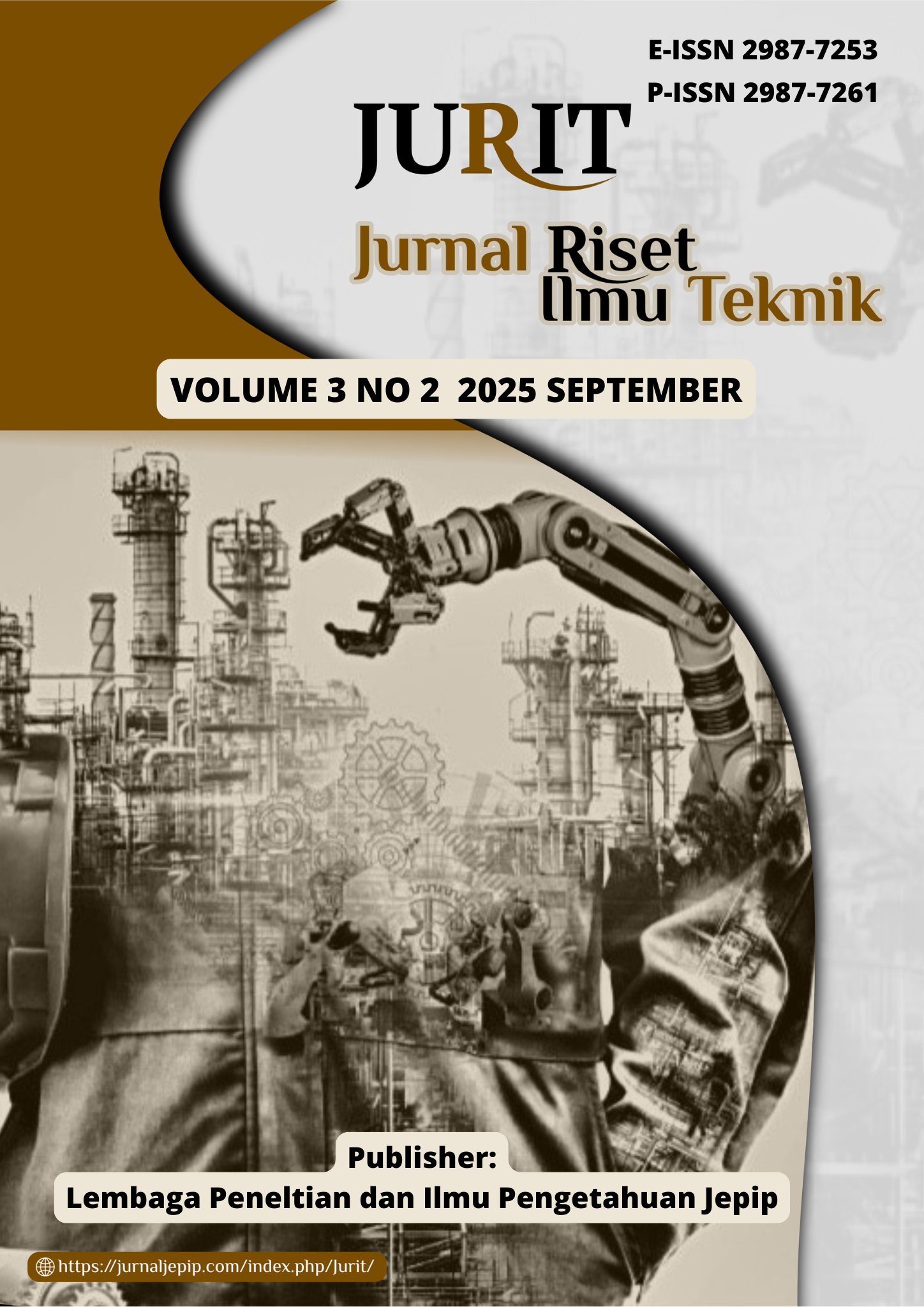Analysis of Prestress Loss and Structural Performance of Box-Type Prestressed Concrete Girders on the Cakung Flyover
DOI:
https://doi.org/10.59976/jurit.v3i2.187Abstract
The increasing traffic congestion in East Jakarta, particularly at the Cakung intersection, prompted the construction of the Cakung Flyover, designed with a prestressed concrete box-girder system. However, field observations revealed several serviceability issues, including hairline cracks (0.10–0.28 mm), vertical deflections of 18–25 mm, and a 30.5 % reduction in effective prestress compared with theoretical design values. This research aimed to analyze prestress losses and their structural implications through an integrated analytical–empirical approach combining field measurements, theoretical modeling, and validation using SAP2000 and MATLAB simulations. The results showed that the box-girder section (A = 5.65 m², Wa = 5.43 m³, Wb = 2.76 m³) exhibited satisfactory flexural rigidity but experienced frictional losses at tendon angular deviations, particularly near anchorage zones. The tropical environment—average temperature 33 °C and relative humidity 85–90 %—accelerated creep, shrinkage, and relaxation in the 7-wire low-relaxation strands. Consequently, measured prestress losses were 1.3–1.6 times higher than those predicted by standard codes. This study confirms that tropical humidity significantly amplifies prestress degradation and highlights the need for climate-specific calibration of SNI 2847:2019 coefficients. The research contributes a calibrated correlation between tendon eccentricity (eₛ ≈ 1.195 m), deflection, and stress relaxation, enabling more accurate prediction and control of structural performance. The proposed framework provides practical guidelines for tendon configuration, prestress monitoring, and maintenance strategies for prestressed concrete flyovers in humid tropical regions such as Jakarta.
Downloads
References
Z. Shao, “A novel train–bridge interaction computational framework based on a meshless box girder model,” Adv. Eng. Softw., vol. 192, 2024, doi: 10.1016/j.advengsoft.2024.103628.
J. Zhang, “Domain-specific large language models for fault diagnosis of heating, ventilation, and air conditioning systems by labeled-data-supervised fine-tuning,” Appl. Energy, vol. 377, 2025, doi: 10.1016/j.apenergy.2024.124378.
M. Calò, “An ML-based framework for predicting prestressing force reduction in reinforced concrete box-girder bridges with unbonded tendons,” Eng. Struct., vol. 325, 2025, doi: 10.1016/j.engstruct.2024.119400.
I. Y. Hakeem, “Analyze the potential for employing internally welded steel plates to improve the shear response of high-strength self-compacting concrete-encased steel beams with large web openings,” Eng. Struct., vol. 304, 2024, doi: 10.1016/j.engstruct.2024.117636.
H. Meng, “Aerodynamics and surrounding flow patterns of a long-span bridge girder model with triple-separated boxes,” Phys. Fluids, vol. 36, no. 3, 2024, doi: 10.1063/5.0195734.
M. Emara, “Shear improvement of defected RC beams with sustainable aluminum boxes incorporating high performance concretes,” Case Stud. Constr. Mater., vol. 21, 2024, doi: 10.1016/j.cscm.2024.e03500.
M. H. Makhlouf, “Experimental and numerical study of shear strengthening of reinforced concrete beams using jute fiber reinforced polymers (JFRP),” J. Build. Eng., vol. 86, 2024, doi: 10.1016/j.jobe.2024.108732.
M. Morgese, “Distributed Detection and Quantification of Cracks in Operating Large Bridges,” J. Bridg. Eng., vol. 29, no. 1, 2024, doi: 10.1061/JBENF2.BEENG-6454.
G. Elsamak, “Embedded aluminum sections and prestressed high-performance concretes for improving shear performance of RC beams,” Case Stud. Constr. Mater., vol. 22, 2025, doi: 10.1016/j.cscm.2024.e04168.
Y. Liu, “Variable fatigue loading effects on corrugated steel box girders with recycled concrete,” J. Constr. Steel Res., vol. 215, 2024, doi: 10.1016/j.jcsr.2024.108526.
Y. Dai, “Buckling resistance of axially loaded cold-formed steel built-up stiffened box sections through experimental testing and finite element analysis,” Eng. Struct., vol. 302, 2024, doi: 10.1016/j.engstruct.2023.117379.
N. Saleem, “Machine learning-based peak ground acceleration models for structural risk assessment using spatial data analysis,” Earthq. Eng. Struct. Dyn., vol. 53, no. 1, pp. 152–178, 2024, doi: 10.1002/eqe.4021.
S. Liu, “Effects of wind-induced static angle of attack on flutter performance of long-span bridges using 2D bimodal and 3D multimodal analysis,” Structures, vol. 63, 2024, doi: 10.1016/j.istruc.2024.106354.
N. Tajik, “Experimental and numerical study on weld strengths of built-up steel box columns,” J. Constr. Steel Res., vol. 213, 2024, doi: 10.1016/j.jcsr.2023.108362.
J. Zhang, “Detecting deck damage in concrete box girder bridges using mode shapes constructed from a moving vehicle,” Eng. Struct., vol. 305, 2024, doi: 10.1016/j.engstruct.2024.117726.
S. Song, “Seismic fragility and vulnerability assessment of a multi-span irregular curved bridge under spatially varying ground motions,” Soil Dyn. Earthq. Eng., vol. 180, 2024, doi: 10.1016/j.soildyn.2024.108585.
J. Zhang, “Driving safety analysis of wind–vehicle–bridge system considering aerodynamic interference,” J. Wind Eng. Ind. Aerodyn., vol. 245, 2024, doi: 10.1016/j.jweia.2024.105649.
G. Zhou, “Explosion resistance performance of reinforced concrete box girder coated with polyurea: Model test and numerical simulation,” Def. Technol., vol. 33, pp. 1–18, 2024, doi: 10.1016/j.dt.2023.08.006.
M. Chen, “Coastal bridges with a box-girder superstructure under the action of solitary waves: Study on the optimization of bearings, dynamic characteristics and failure mechanism,” Ocean Eng., vol. 308, 2024, doi: 10.1016/j.oceaneng.2024.118316.
P. Ge, “A machine learning based method for predicting the shear strength of Fiber-Reinforced Concrete joints in precast segmental bridges,” Eng. Struct., vol. 302, 2024, doi: 10.1016/j.engstruct.2023.117324.
X. Liu, “Dynamic response analysis for bridges subjected to moving vehicle loads by using the analytical dynamic stiffness method,” Comput. Struct., vol. 292, 2024, doi: 10.1016/j.compstruc.2023.107240.
X. Liu, “Experimental and numerical study on vibration and structure-borne noise of composite box-girder railway bridges,” Int. J. Rail Transp., vol. 12, no. 1, pp. 134–152, 2024, doi: 10.1080/23248378.2022.2131641.
C. Hu, “Spatio-temporal distribution of aerodynamic forces and their associated vortex drift patterns around a closed-box girder during torsional vortex-induced vibration,” Eng. Struct., vol. 302, 2024, doi: 10.1016/j.engstruct.2024.117459.
D. Tabiatnejad, “Damage Detection in External Tendons of Post-Tensioned Bridges,” Infrastructures, vol. 9, no. 7, 2024, doi: 10.3390/infrastructures9070103.
Y. Cheng, “Uncertainty propagation of flutter analysis for long-span bridges using probability density evolution method,” Reliab. Eng. Syst. Saf., vol. 251, 2024, doi: 10.1016/j.ress.2024.110361.
Downloads
Published
How to Cite
Issue
Section
License
Copyright (c) 2025 Aldo Dion Selvistre, Viona Yeni, Putut Keswardi

This work is licensed under a Creative Commons Attribution 4.0 International License.

















